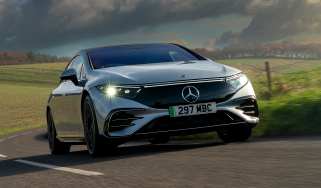Jaguar XKR-S Coupe
Potent Brit supercar delivers huge performance and thrills
Any car billed as the most driver-focused machine its maker has ever produced has a lot to live up to. And when the brand in question is Jaguar, expectations will be sky-high.
The British firm has hit the jackpot with the styling, if our experience is anything to go by. Despite the familiarity of the XK’s lines, the white XKR-S we tested drew as many admiring glances on the road as the rarer Maserati.
Smart LED running lights now feature across the XK line-up, and take much of the credit. Side slots on the front bumper, twin air scoops above the grille and a deeper spoiler do the rest.
Wide wheelarches, extended side sills and a big rear wing complete the sporty appearance. This visual effort isn’t simply to turn heads, though. The spoilers and skirts help reduce lift by 26 per cent, which is just as well when you consider a revised ECU and exhaust have upped power from the standard XKR’s 503bhp to 542bhp. That’s enough for a top speed of 186mph. And, with 680Nm of torque on tap, acceleration is effortless.
Few cars we’ve driven feel as fast on the open road. Peak torque arrives at 2,500rpm, and the XKR-S was faster in all of our in-gear tests. The XK’s existing Achilles heel hasn’t been fixed, though – the lack of traction off the line means the Jaguar and Maserati are closely matched in the sprint from 0-60mph.
Used - available now

2023 Jaguar
I-PACE
18,630 milesAutomaticElectric
Cash £24,800
2024 BMW
i4
25,783 milesAutomaticElectric
Cash £32,800
2020 Volkswagen
Polo
51,454 milesManualPetrol1.0L
Cash £10,550
2024 Peugeot
2008
9,274 milesAutomaticPetrol1.2L
Cash £18,168Inside, changes from lesser XK models are less obvious. You get embossed R-S badges on the multi-adjustable sports seats, and it’s hard to fault the subtle and smartly designed Jaguar cabin, but it lacks the special feel of the Maserati. Standard equipment is generous and the hatchback tailgate and tiny rear seats make the XK more practical than its Italian rival.
The supportive seats and six-speed automatic gearbox help to make the XKR-S more relaxed to drive than the Maserati in daily use. And it’s the better choice for long-distance cruising. However, its 20-inch wheels and 10mm lower suspension mean the ride is still firm.
Other changes include new aluminium steering knuckles to increase precision, plus revised rear suspension geometry and an updated differential. Despite all this, the Jaguar doesn’t have the grip of the Maserati, and it feels soft when driven back-to-back with its rival on challenging roads.
The huge amount of power under your right foot makes it very easy to trigger the stability control, but the chassis delivers lots of feedback, making the XKR-S reassuringly playful and easy to control when the safety system is switched off.
So, while it’s not a hard-edged track-inspired machine in the same vein as the Stradale, the flagship coupe is still really likeable with its combination of performance and fun. The problem is, the standard XKR achieves much of this without the hefty price tag. So, has Jaguar done enough for its new S to win?
Details
Chart position: 2
WHY: Pinnacle of Jaguar’s R range takes the established XK into new territory. Enhanced pace, styling and handling are the result.



